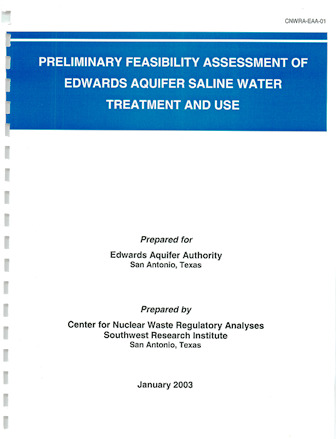Preliminary Feasibility Assessment of Edwards Aquifer Saline Water Treatment and Use

| Author | Pabalan RT, Daruwalla DD and Green RTRT (SWRI Center for Nuclear Waste Regulatory Analyses) |
| Year | 2003 |
| Description | Feasibility of desalination from the Edwards Aquifer for public drinking water |
| Report Number | SwRI Report CNWRA-EAA-01 |
| Publisher | Southwest Research Institute® |
| Location | Edwards Aquifer, Balcones Fault Zone, San Antonio Segment |
| Cover | View Download |
| File | View Download |
| Summary |
|
The Edwards Aquifer is the primary source of water for more than one million people in and near San Antonio, Texas, and supplies potable water as well as water for agricultural, industrial, and recreational purposes throughout an 8,000-square-mile area of south-central Texas. In the last five decades, increased population growth and water demand in San Antonio and surrounding areas have resulted in dramatic increases in average pumping from Edwards Aquifer wells. Water resource planners project that by the year 2020, demand for water in the Edwards Aquifer region could be 863,000 acre-feet per year. Water authorities and other entities in the Edwards Aquifer region, as well as in other parts of Texas, are concerned about potential shortfalls in future water supplies relative to future needs. For example, the 2002 Texas State Water Plan warns that about 900 cities and water user groups in Texas could face water shortages during droughts within the next fifty years unless demand for water is reduced and/or additional water sources are developed. In response to these concerns, public and private entities in Texas are evaluating and implementing desalination projects as alternative water sources. Desalination is a process that removes substances and minerals from brackish (or saline) ground and surface water, or seawater. Desalination is recommended in the 2002 State Water Plan as a water management strategy to produce additional water supplies in several regions of Texas, including the south-central Texas region. The technology is particularly promising for the Edwards Aquifer region because of the presence of an extensive saline-water zone in the Edwards Aquifer, downdip of the fresh water zone. The saline-water zone has not been tapped as a water source due to the high dissolved solids concentration (1,000 to over 10,000 mg/L), but it has the potential to be an important source of water if desalination technology becomes an economically viable choice. As demand for water in the Edwards Aquifer region starts to exceed the availability of fresh water from the aquifer, desalination of water pumped from the saline-water zone likely will become increasingly important. This document was prepared for the Edwards Aquifer Authority and presents a preliminary study on the feasibility of pumping and treating saline water from the Edwards Aquifer to produce potable water. The report provides background technical information on reverse osmosis (RO) and electrodialysis reversal (EDR)-the dominant desalination technologies for municipal water treatment plants, and summarizes information on existing and planned municipal water treatment plants employing similar technologies. Preliminary cost curves are calculated for the treatment of saline waters as a function of operating parameters. The estimated costs are compared with cost data from existing plants and with estimated costs taken from the literature or provided by a vendor. In addition, preliminary estimates of potential yield from wells that may tap the Edwards Aquifer saline-water zone are made to determine if sufficient saline water could be drawn from the aquifer for use as feedwater for the desalination facility. |
Search for Documents
Advance Search
Explore EAA's Scientific Reports
- All Reports
- Hydrology and Hydrogeology
- History
- Groundwater Recharge, Recharge Zone
- Groundwater Movement
- Geomorphology and Caves
- Weather Modification
- Geology
- Water Use and Conservation
- Geochemistry
- Water Resources Planning and Management
- Floods and Drought
- Water Quality
- Climatology
- Surface Water / Groundwater Relationship
- Biology
- Springs, Groundwater Discharge
- Archaeology
- RZ Protection
- Aquifer Levels
- Remote Sensing
- Precipitation
- Overview Studies
- Modeling
